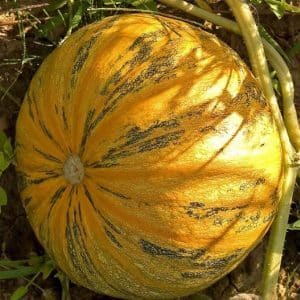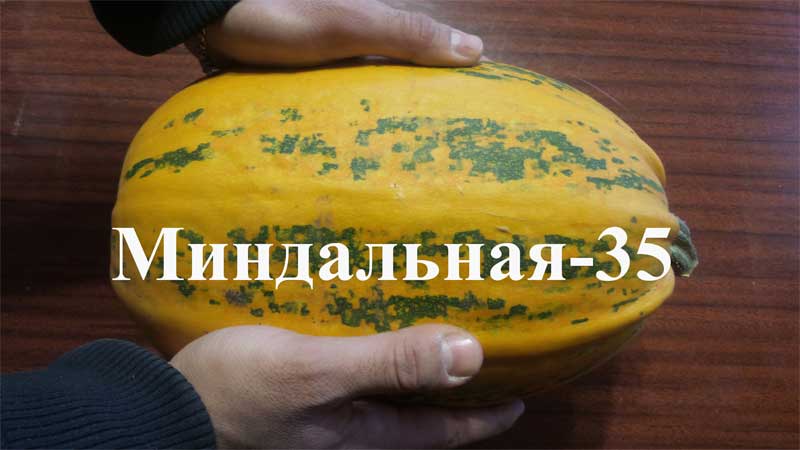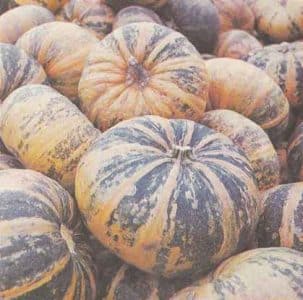What is good about almond pumpkin and how to grow it
Tasty and healthy pumpkin has been grown by humans for hundreds of years. The birthplace of the culture is hot Mexico. Despite its southern origin, pumpkin is surprisingly unpretentious and grows in a wide variety of climatic conditions.
Variety of varieties, bred by breeders, is amazing. For those who first decided to grow a vitamin beauty on their own, it is easy to get confused when seeing the variety of shapes, colors and sizes. The article describes in detail the Almond 35 variety with a delicate almond aroma and how to grow these delicious fruits on your site.
Description of the variety
The Almond 35 variety was developed 70 years ago. It was recommended for cultivation throughout Russia (except for the northern regions).
This variety of pumpkin crop is distinguished by powerful bushes with long shoots. The lashes grow up to 8 m in length. The leaves of the plants are large and pentagonal in shape.
Pros and cons of the variety
The advantages of the variety include the excellent taste of the fruit. The pulp of almond pumpkin is dense and sweet (this is one of the most sugary varieties). Ideal for blanks.
The fruits are distinguished by their keeping quality and ability to withstand long-term transportation. Almond squash is relatively resistant to squash blight, powdery mildew, and bacterial spot.
The strong climbing habit of the variety does not allow it to be grown in small garden plots and vegetable gardens. For full growth, the almond beauty needs a lot of space. The variety is demanding on soil nutrition. Regular, abundant watering and fertilizing are needed.
As the name suggests, a characteristic feature of the variety is the delicate almond aroma of the pulp. Thanks to its high taste, children eat dishes made from this pumpkin with pleasure.
Fruit characteristics and yield
What type of almond pumpkin is it? This is a hard-barked, long-climbing variety that is demanding on heat and growing conditions.
With proper care, almond pumpkins grow up to 5 kg. The shape of pumpkins is flattened or cylindrical. The bark is smooth or slightly segmented. The peduncle is ribbed, pentagonal in shape.
Ripe fruits have a rich brown-orange color. As you can see in the photo, there are dark green stripes on the rind of the fruit, which lighten as the pumpkins ripen. The bark is dense and elastic. The thickness of the juicy, orange pulp is 4-5 cm.
Pumpkin Almond 35 is a mid-season variety. It takes 110-120 days from the emergence of seedlings to harvest. Average yields are 2.2-4.4 kg per m².

How to grow almond squash yourself
If you decide to grow almond pumpkin on your plot, consider a few points:
- the pumpkin root system is located close to the surface of the earth, so it is important to provide the plants with fertile topsoil;
- almond pumpkin has a lot of branches, the bushes need a lot of space;
- Choose a sunny place for planting.
Landing
The bed is prepared in the fall. The soil is dug up and organic and mineral fertilizers are applied. If the soil is light, then the seeds are planted directly into the ground. If the soil is heavy and damp, make high beds.
Need to know. Good predecessors for pumpkin are eggplants, carrots, peas, potatoes, cabbage, and bulbous crops. Bad ones are related crops, such as zucchini, cucumbers, and squash.
The optimal time for sowing occurs when the soil has warmed up to a temperature of at least +14 °C. At lower temperatures, seeds do not germinate and rot in the soil.
The prepared holes are watered with warm water. Seeds are planted to a depth of 10 cm if the soil is light, and 3-4 cm if the soil is heavy. Plantings are mulched with peat chips or humus. These simple measures increase germination and facilitate further care of the crops.
Almond pumpkin is grown in 2 ways:
- Sowing seeds in open ground in the second half of May.
- Through seedlings grown in a greenhouse or at home a month before planting in open ground.
Important. Pumpkin seedlings do not like picks. Seeds are immediately planted in individual 500 ml containers.
The key to obtaining strong and healthy seedlings is the correct selection and preparation of seed material. Pumpkin seeds are prepared independently or bought in specialized stores. Seed preparation involves heating, disinfecting and germination.

Heat the seeds at a temperature of 40 °C for several hours. For planting, choose healthy, heavy seeds without damage and signs of disease.
Then the pumpkin seeds are soaked in a solution of potassium permanganate. Disinfection will protect tender young plants from diseases and pests. After half an hour, the seeds are removed from the potassium permanganate, washed and wrapped in a damp cloth. So the seeds are kept for several days before hatching.
After the sprouts appear, the seeds are planted in the ground. The soil mixture is prepared independently from peat, turf soil and humus (in a ratio of 2:2:1) or ready-made soil for pumpkin crops is used. The prepared containers are filled 2/3 with soil and planting begins.
The seeds are buried 2-3 cm.Germinated seeds will sprout in 3-5 days, unprepared seeds - in 10-14 days. After germination, containers with seedlings are transferred to a cool place. Lowering the temperature to 15-18 °C will prevent plants from stretching. After a week, the seedlings are again transferred to warmth.
Water the seedlings regularly, but moderately. For irrigation, use settled water at room temperature. The soil should not be allowed to dry out before sprouts appear; this will lead to the death of the plants. Overmoistening of the soil is also dangerous for seedlings. Excess moisture provokes the appearance of rot and disease.
7-10 days after emergence, the seedlings are fed. It is good to use nitrophoska as a fertilizer (in accordance with the instructions).
On warm days, seedlings are taken outside for hardening. Pumpkins are planted in open ground when the threat of return frosts has passed. After all, this southern culture does not tolerate cold weather.
Care
Caring for almond pumpkin plantings involves timely watering, loosening the soil, applying fertilizers and forming bushes.
Watering

Pumpkin Almond 35 is a moisture-loving variety that requires abundant watering. Powerful bushes have a developed root system, and large leaves evaporate a lot of moisture.
Particular attention is paid to watering during the period of plant flowering and fruit formation. Warm and settled water is used. Stop watering 3-4 weeks before harvest. This way the fruits will gain more sugars and taste better.
Feeding
Getting large pumpkins This is only possible if a sufficient amount of fertilizer is added to the soil. The first feeding is carried out when 3-5 leaves are formed. The next time fertilizer is applied after 3 weeks.
For feeding, use nitrophoska (in accordance with the instructions).In wet weather, fertilizers are applied in dry form. When dry, fertilizing is combined with watering.
Feeding pumpkin plantings with ash (1 cup per plant) and mullein solution (1:8) is effective.
Formation of bushes
When growing almond pumpkin in the southern regions of our country, pumpkin bushes do not need to be formed. With enough sunny, hot days, all the formed fruits will have time to ripen.
However, in the conditions of the short and cool Siberian summer, the southern beauty pumpkin does not always have time to reach technical maturity before the end of the season. An agricultural technique such as the formation of a pumpkin bush allows you to accelerate the ripening of fruits.
Advice. When growing Almond pumpkin in regions with short and cool summers, do not neglect the formation of pumpkin bushes. This simple technique will bring the harvest closer.
Shaping involves removing excess lashes and ovaries. The procedure allows the plant to concentrate on ripening the formed fruits without wasting energy on the green mass. There are 2 main ways to form a pumpkin - in 1 or 2 stems.
When forming into 1 stem, all side lashes and excess ovaries are removed immediately after they appear. 2-3 ovaries are left on the stem. After the last ovary, 4-5 leaves are counted and the tip of the shoot is pinched. This way you will get the largest fruits. All newly appearing shoots and flowers are removed.
When forming a pumpkin bush with 2 stems, 2 fruits are left on the main shoot, and 1 on the side shoot. On each lash, after the last fruit, 4-5 leaves are left, and the tops of the shoots are pinched.
The overgrown lashes are laid in the desired direction and sprinkled with earth in several places.In this way, additional roots are formed, fixing the lashes in place and giving the fruits additional nutrition.
Prevention of diseases and pests
Pumpkin plantings, like other garden crops, are subject to attack by pests and the development of diseases. We list the common diseases that pumpkin plants are susceptible to.
Bacteriosis
One of the common diseases affecting pumpkin plantings. The disease is recognized by light brown spots on the cotyledons and angular spots on the foliage. Affected plant tissues become dark, dry out and die.
An effective preventive measure to prevent the development of bacteriosis is compliance with the rules of crop rotation. Spraying with 1% Bordeaux mixture is carried out when the first signs of the disease appear. The treatment is repeated after 10-14 days.
Root rot
The disease affects the root system of the plant. The stems darken, the bush stops growing, the lower leaves turn yellow and dry out. The development of the disease is provoked by differences in day and night temperatures, as well as the use of cold water for irrigation. At the first signs of root rot, soil is added to the stems to form additional roots.
White rot
The development of the disease is indicated by the appearance of a white coating on the foliage and stems of the pumpkin bush. The affected parts of the plant become soft and slimy to the touch. If a disease is detected, the affected parts of the bush are cut off. The cut areas are treated with a solution of copper sulfate (the solution is prepared at the rate of 30 g per 3 liters of water).
Powdery mildew
Another common disease that affects all pumpkin crops. The disease is recognized by a white coating that causes wrinkling and death of foliage.The disease is treated with ground sulfur and 80% colloidal sulfur solution. These products are used to treat the affected parts of the bush.
The following pests cause great harm to pumpkin plantings: spider mites, slugs and melon aphids.
Spider mite
The mite settles on the underside of the leaves, entwining the plant with a thin web. The foliage turns yellow and dries. If the pest is not dealt with, the entire bush will die. Spraying the leaves with a strong solution of onion peel (3 kg per 10 liters of water) helps to effectively combat mites.
Slugs
They eat young plant leaves, slowing down the growth of the bush. Loosening the soil and removing weeds is an effective prevention of pest attacks. Laying out traps made of wet rags, cabbage leaves, and watermelon rinds also helps.
melon aphid
This insect lives on weeds, after which it moves to pumpkin plants. Aphids live on the underside of leaves, shoots, ovaries and flowers. It feeds on plant sap. Leaves affected by the pest curl and fall off. The growth of the bush slows down or stops completely. An effective control and prevention measure is spraying plants with a solution of karbofos (at the rate of 100 g per 10 liters of water).
Reviews from gardeners
 What do gardeners say about this unusual variety with the aroma of almonds? Here are some reviews.
What do gardeners say about this unusual variety with the aroma of almonds? Here are some reviews.
Elizaveta, Kommunar: “We grow almond pumpkin every year. Plant seeds directly into open ground. Does not require special care. The main thing is not to be late with the start of the sowing campaign, otherwise the pumpkins will not have time to ripen before the onset of cold weather.”
Tatyana, Tambov: “We plant pumpkins every summer. The culture is unpretentious and does not require special care. Almond pumpkin is especially delicious. Grind the pulp, pack it into bags and freeze. And in winter I cook delicious porridge with pumpkin.My whole family likes it, even the children eat it with pleasure. Tasty and healthy!".
Andrey, Velikiye Luki: “Almond pumpkin does not require special growing conditions. The harvest is stored for a long time, so we eat pumpkin pies until spring. It is convenient to grow pumpkin in barrels. This saves a lot of space on the site.”
Conclusion
Growing a rich harvest of tasty and healthy almond pumpkin is not difficult. It is enough to choose a spacious, sunny place for the garden bed, water and fertilize the plants in a timely manner.
When grown in central Russia, the seedling method is used, then the pumpkins have time to ripen before the end of the season and are well stored in winter.